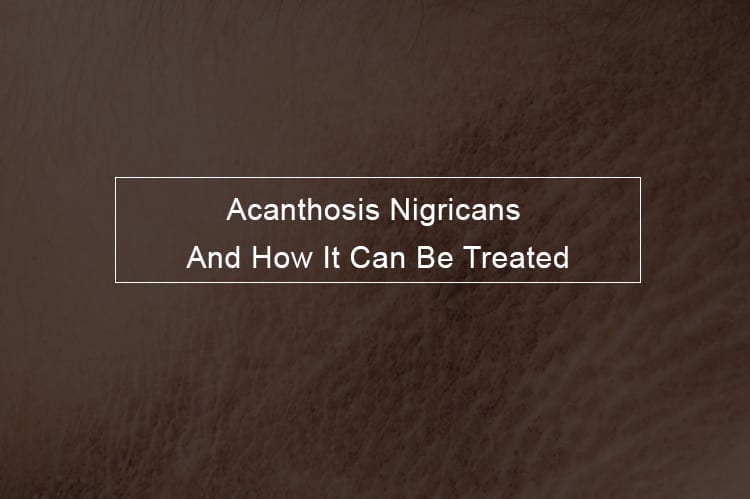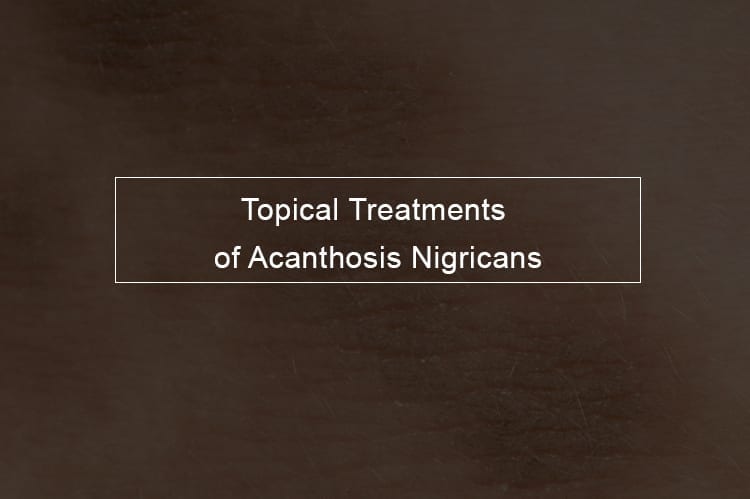
What is acanthosis nigricans?
Acanthosis nigricans is a skin coloring disorder. The most notable indication of acanthosis nigricans is dark patches of skin with a thick, soft texture. The impacted locations of the skin may also itch or have a smell.
What are the signs of acanthosis nigricans?
Where acanthosis nigricans appear?
These spots might appear on skin folds and also the following places:
- neck
- underarms
- groin
- lips
- palms
- elbows
- knees
- knuckles
- soles of the feet
Acanthosis nigricans might signify a more major health problem, such as prediabetes. The most effective treatments concentrate on finding and solving medical conditions at the root of the issue. These skin patches tend to vanish after successfully dealing with the root condition.
Who is at risk for acanthosis nigricans?
Acanthosis nigricans is seen in both males and females. However, people with obesity, people with diabetes or prediabetic conditions, and people with darker skin are at more risk of having this condition. Kids who develop acanthosis nigricans are at a higher risk of developing type 2 diabetes later on in life.The frequency of acanthosis nigricans differs between ethnic groups. Individuals of African, Hispanic, or Caribbean descent are at a higher risk. Nevertheless, people from all the other ethnic groups are also at risk of acanthosis nigricans when body mass index (BMI) is high.
What causes acanthosis nigricans?
Is acanthosis nigricans a sign of diabetes?
Acanthosis nigricans occurs when epidermal skin cells begin to reproduce rapidly. This abnormal skin cell growth is most frequently set off by high levels of insulin in the blood. Cancer, other medical conditions, and some medications can also cause acanthosis nigricans. These are however rare causes.
Excessive insulin can result in acanthosis nigricans
The most common cause of acanthosis nigricans is too much insulin in your blood. Your body usually converts carbohydrates into sugar molecules such as glucose when you eat. The glucose gives the cells energy while the rest is preserved. Insulin must permit glucose to go into cells so that the cells can use glucose for energy.Obese people gradually form a resistance to insulin.
The insulin is still produced by the pancreas, but the body can't utilize it effectively. This develops an accumulation of glucose in the bloodstream, which can result in high levels of both blood sugar and insulin in your blood stream.Excess insulin causes regular skin cells to reproduce very fast. The cells have more melanin in people with dark skins. This, therefore, means that there will be patches on the skin that are darker than the surrounding skin. Thus, acanthosis nigricans is a strong predictor of future diabetes. If you are sure that excess insulin is the cause of your acanthosis nigricans, then it is relatively easy to remedy with proper diet, controlling the blood sugar, and regular workout.
Some medications can trigger acanthosis nigricans
Acanthosis nigricans can likewise be caused by some medications such as thyroid medications, birth control pills, some bodybuilding supplements, and human growth hormones. These medications all change the insulin levels. Medications used to alleviate the negative effects of chemotherapy have likewise been connected to acanthosis nigricans. The condition usually clears up when the medications are stopped.
Other potential causes of acanthosis nigricans
In rare cases, acanthosis nigricans can be brought on by:
- stomach cancer, or stomach
- adenocarcinoma
- low levels of thyroid hormones
- adrenal gland conditions, such as Addison's illness
- disorders of the pituitary gland
How is acanthosis nigricans diagnosed?
Acanthosis nigricans can easily be seen. The doctor might first do tests to check for diabetes or insulin resistance as the cause. These tests might include fasting insulin tests or blood glucose tests. Your current medications will also be looked at to see if they are a contributing factor. You should inform your doctor about any dietary supplements, vitamins, or bodybuilding supplements you might be taking in addition to your prescription medications. Some times the doctor might do a small skin biopsy to eliminate other possible causes. This is very rare.
How is acanthosis nigricans treated?
Acanthosis nigricans is a symptom of another condition that may require medical attention; it is not a disease by itself. Treatment is mainly focused on attending to the condition that's causing it. If you are overweight, your doctor will recommend you reduce your weight. Your physician may also recommend medications that bring your blood sugar under control.If the condition is triggered by medications or supplements, the doctor can recommend alternatives and have you stop the current medications. The stained skin patches will normally fade when you find the cause and get it under control.

Topical retinoids for acanthosis nigricans
Topical retinoids are usually among the first treatment options for acanthosis nigricans. In a study of 30 acanthosis nigricans patients, improvements were seen in all patients after 14 days of 0.05% tretinoin application. Of the 30, 24 showed overall clearance at 16 weeks. Nevertheless, intermittent tretinoin was needed to maintain the results as relapse was noted within a duration of 4 weeks after discontinuation of treatment.
Topical vitamin D analogs for acanthosis nigricans
Calcipotriene is another topical treatment choice for acanthosis nigricans. The vitamin D analog is believed to have keratinocyte proliferation and promote differentiation. By minimizing the number of keratinocytes, it may lessen the cutaneous impacts of insulin.
Chemical peels for acanthosis nigricans
Superficial chemical peels are a relatively safe and effective treatment choice for acanthosis nigricans. Trichloroacetic acid (TCA) is a chemical exfoliating agent that triggers the destruction of the epidermis. This results in skin repair and rejuvenation. The destruction is followed by swelling and the activation of wound repair, triggering the formation of new smooth skin.
Oral treatment for acanthosis nigrican
Using oral retinoids (isotretinoin and acitretin) to deal with acanthosis nigricans. Oral retinoids such as acitretin and isotretinoin are viable treatments for acanthosis nigricans. However, improvement needs large dosages. It is suggested that these drugs work by normalizing the epithelial growth and differentiation.
Other oral agents for acanthosis nigricans
Thiazolidines are medications that increase insulin sensitivity in peripheral muscles. Combining thiazolidines with metformin has also been reported to work for people with acanthosis nigricans. Hyperandrogenemia, insulin resistance, and acanthosis nigricans syndrome patients might likewise be treated with a mix of metformin and oral contraceptives.
Using metformin and rosiglitazone to deal with acanthosis nigricans
If the cause of acanthosis nigricans is the resistance to insulin, then the standard insulin-sensitizing agents like metformin are used. Metformin increases peripheral insulin responsiveness, leading to a reduction of hyperinsulinemia, glucose production, body weight, and fat mass, along with a boost in insulin sensitivity in patients with insulin resistance and acanthosis nigricans.
Other therapies for acanthosis nigricans
Other treatments that have improved acanthosis nigricans include podophyllin, fish oil, and combination therapy with salicylic acid, urea, and triple-combination depigmenting cream. Fish oil has in some cases improved hyperpigmentation and skin texture. This is because it is rich in omega-3 fatty acids.
Podophyllin for acanthosis nigricans
Podophyllin 20% in alcohol has actually been reported to momentarily solve acanthosis nigricans sores of the hands. Other treatment choices that have been reported with variable outcomes include the application of salicylic acid and topical urea.
Alexandrite laser for acanthosis nigricans
Use of alexandrite laser is another cosmetic treatment choice that has been demonstrated to be effective in enhancing acanthosis nigricans sores. After seven treatments with long-pulsed alexandrite laser over 95% clearance in the left axilla was observed. This laser was developed to target melanin in the hair and was assumed to enhance the darkening of the skin in impacted areas. Although it is not economical compared to other topical and oral treatment alternatives, the use of alexandrite laser for treatment of acanthosis nigricans is a promising prospect.
Conclusion on treating acanthosis nigricans
Present treatment paradigms for acanthosis nigricans are shifting to include dealing with the cutaneous pathology as well as the underlying disease or drug. Non-medication options consist of weight loss and workout to increase the sensitivity of insulin in insulin-resistant acanthosis nigricans.Treatment of acanthosis nigricans is multifactorial due to the fact that the skin findings are frequently accompanied by an underlying disease. Initial factors to consider for acanthosis nigricans include assessing patients for insulin resistance syndrome identified by weight problems, high blood pressure, dyslipidemia, and diabetes mellitus type II. Providers ought to get a fasting lipid panel, insulin, and glucose, along with liver function testing and a complete blood count.
If you consider malignancy-associated acanthosis nigricans, imaging studies such as computerized tomography/magnetic resonance imaging and plain radiography might provide valuable details. Oral metformin and other insulin-mediating medications are effective, as they are therapies aimed at dealing with the underlying causes adding to acanthosis nigricans.For cosmetic treatment, the first-line therapy for insulin-resistant acanthosis nigricans is topical retinoids. They modify the keratinization rate. However, topical tretinoin needs an application for a long period of time and only improves hyperkeratosis and not hyperpigmentation. Topical salicylic acid, urea, podophyllin, and calcipotriol also require frequent application, while TCA peels may provide a much faster solution. Other alternatives consist of alexandrite laser or dermabrasion; however, these alternatives comes with the risk of post-inflammatory hyperpigmentation and are far more expensive.




